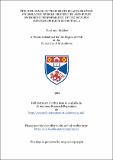The influence of temperature acclimation on isolated muscle properties and burst swimming performance of the sculpin (Myoxocephalus scorpius L.)
Abstract
A brief history of fish biomechanical studies is given and a general introduction on the composition and functional properties of fish muscle, in relation to different swimming activities is presented. Thermal adaptations in teleost fish over both evolutionary and seasonal time scales are discussed at different levels of biological organisation.
Chapter 2 The isometric properties of live fast fibres, isolated from the abdominal myotomes of the short-horned sculpin (Myoxocephalus scorpius) were examined at temperatures of 5, 10 and 15°C. The properties of fibres isolated from laboratory-acclimated (5 and 15°C) and naturally-acclimatised, summer (July - September) and winter (January - March) fish were compared to assess the modulating effect of environmental factors other than temperature.
Chapter 3 Live fast fibre bundles were isolated from the abdominal myotomes of naturally acclimatised (summer and winter) and laboratory acclimated (5°C and 15°C) sculpin. Force-velocity (P-V) characteristics of the fibres were investigated using iso-velocity releases. The mechanisms behind the acclimatory increases in power output in summer and 15°C-acclimated fish, at 15°C are partly due to increases in the Vmax of the fibres. More importantly force generating capacity shows a major acclimatory adaptation which greatly enhances power output at warm temperatures.
Chapter 4 Short-horned sculpin were acclimated to either 5 or 15°C (12 h light: 12 h dark) for 6 - 8 weeks. Prey-capture of Crangon crangon was filmed at 200 frames s-1, using a high speed video. The fish employed the three classic kinematic stages as described by Weihs (1973) in a typical "S" shaped fast start. The kinematics of the fast start were unaffected by temperature or acclimation state. 5°C-acclimated sculpin were tested at 5, 10 and 15°C. Rates of acceleration doubled in the 5°C-acclimated fish between 5 and 15°C. Tail-beat frequency also increased significantly from 5.5 Hz at 5°C to 8 Hz at 15°C. However, mean and maximum velocity and tail-beat amplitude were relatively independent of test temperature.
Chapter 5 Fast muscle fibres were isolated from rostral and caudal myotomes of summer-caught, short-horned sculpin. Muscle strain patterns for three positions (0.31L, 0.52L, 0.77L) along the body were calculated from changes in body curvature, during fast-starts at 15°C. Isolated rostral and caudal muscle fibres were subjected to the in vivo strain fluctuations and stimulated with a similar duty cycle (25 - 32%) to that found in vivo. Work loops were generated by plotting force and length. The effect of varying muscle stimulation phase on power output and force generation was investigated. At the anterior position in the body the rostral fibres produced significantly greater force (41.9 kN m-2) compared to the caudal fibres (12.2 kN m-2). Similarly, power output at position 1 was also significantly greater in rostral fibres (28.0 W kg-1) compared to caudal fibres (3.7 W kg-1). No difference was found in the properties of the fibres at positions 2 and 3. This suggests that the rostral fibres have adapted to their local mechanical environment to increase force and power generation, although the mechanisms responsible are unknown.
Chapter 6 The major findings of this thesis are discussed relating different aspects of muscle performance to locomotory capabilities of sculpin. Thermal adaptations over the natural environmental temperature range encountered by sculpin are considered and the possible mechanisms involved are discussed. Finally, suggestions for elucidating the molecular mechanisms behind adaptations in the shortening speed and force generation are presented. (Abstract shortened by ProQuest.)
Type
Thesis, PhD Doctor of Philosophy
Collections
Items in the St Andrews Research Repository are protected by copyright, with all rights reserved, unless otherwise indicated.

